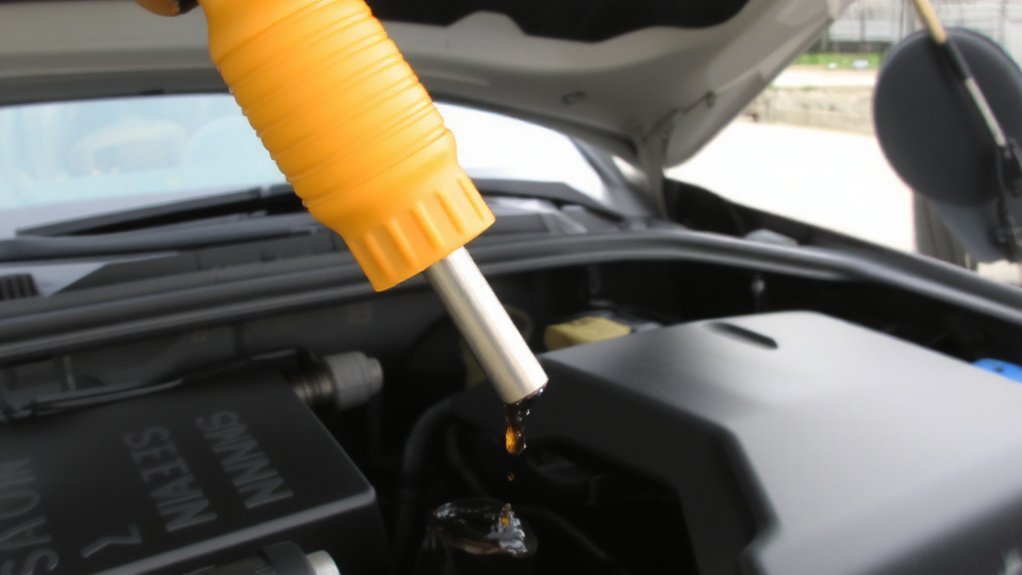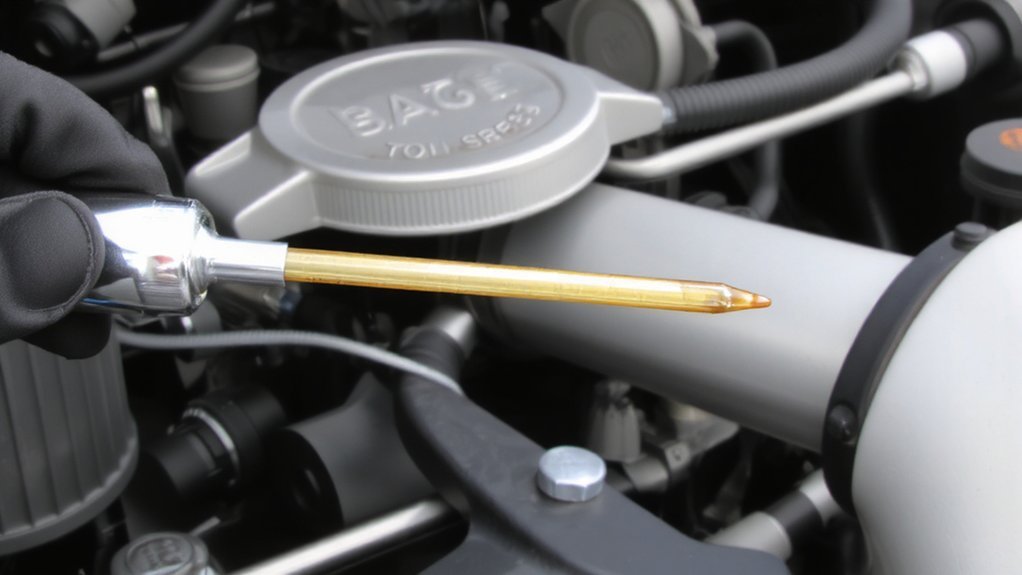You’ll want to check your oil on level ground with the parking brake set and the engine off so the oil can settle. Open the hood, find the dipstick, wipe it, reinsert it, then pull it out to read the level and inspect color and smell. Keep going to learn the simple, safe steps.
Preparation Before You Begin

Before you start checking the oil, make sure the car is parked on level ground and the parking brake’s set.
Turn off the engine and let it sit five to ten minutes so oil drains into the sump; some manuals recommend a cold start check—follow yours.
Gather a clean rag, disposable gloves, a flashlight, and a funnel if you might top off.
Wear clothes you don’t mind staining.
Locate the owner’s manual to confirm the correct oil grade and the dipstick’s appearance or marking.
Note ambient slope if you parked in a driveway; even slight lean alters the reading.
Have paper and pen to record the date, mileage, and any visual oil notes.
You’re ready to proceed calmly and safely without rushing or guessing.
Opening and Securing the Hood

With the car settled, locate the interior hood release—usually under the dash or near the driver’s door—and pull it to pop the latch.
Walk to the front, feel under the hood center for the secondary release or small lever, push or lift it to free the hood, then raise the hood using both hands.
If your hood has a prop rod, unclip it, insert the end into the designated hole or slot, and ensure the rod seats firmly.
If it uses gas struts, lift slowly until they hold it open.
Give the hood a gentle upward push to confirm it’s secure. Never work with a hood that’s wobbly; lower and repeat securing steps if needed before you proceed. Check for tools or debris first.
Finding the Oil Dipstick

Where’s the dipstick? You’ll usually find it near the front or side of the engine, a long metal rod with a brightly colored (often yellow or orange) loop or handle.
If the engine has a plastic cover, look for a labeled access point or remove the cover per your manual before searching.
Some modern cars use a cap-style filler or electronic sensors instead of a visible dipstick — check the owner’s manual or the engine bay labeling.
When you spot a loop or handle, pull gently to confirm it’s the dipstick and not a hose or tether.
Keep the area around the tube clean so contamination doesn’t enter when you remove the dipstick later.
If in doubt, take a photo and consult manual.
Reading and Interpreting the Oil Level

How do you tell if the oil level is right? Pull the dipstick, wipe it clean, reinsert fully, then pull it again to read. Hold the dipstick horizontally and compare the oil mark to the crosshatch, holes, or min/max indicators.
If the oil reaches between the two marks or within the safe zone, your level’s good. If it’s below the lower mark, it’s low; if it exceeds the upper mark, it’s overfilled.
Also check oil color and texture: amber and translucent is normal; very dark, gritty, or milky oil signals contamination or wear and needs inspection. Smell for fuel or coolant odors.
After reading, reinsert the dipstick fully and secure the cap. Note readings with date and mileage for trends. Track changes over time.
How to Add Oil Safely

Before you add oil, park on level ground, shut the engine, and let it sit for a few minutes so the oil drains back to the pan. Gather the correct oil type and a clean funnel, and check the owner’s manual for capacity and viscosity.
Clean the filler cap area to keep dirt out, remove the cap, and slowly pour while watching the dipstick to avoid overfilling. Add small amounts, wait a minute, then recheck level; repeat until the dipstick shows within the safe range.
Wipe any spills immediately and replace the cap securely. Dispose of or store leftover oil properly.
If you’re unsure, consult a mechanic—overfilling can harm the engine, and contamination reduces performance. Use gloves and absorbent pads to protect surfaces properly.
Conclusion
You’re ready to check your oil: park level, set the brake, shut the engine off and wait a few minutes for oil to settle. Open and secure the hood, pull the dipstick, wipe it, reinsert fully, then pull and read between the min/max marks. Smell and look for contamination. If low, clean the filler cap area and add the correct oil gradually, rechecking until the level’s within range and the cap’s secure and you’re done.